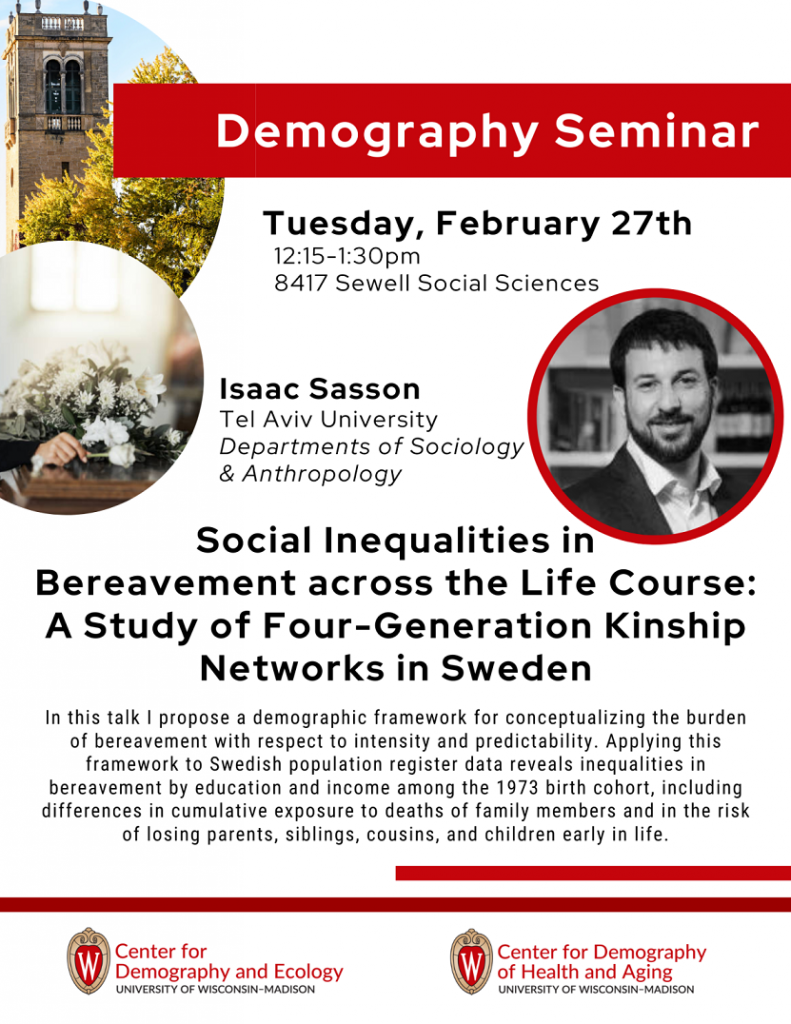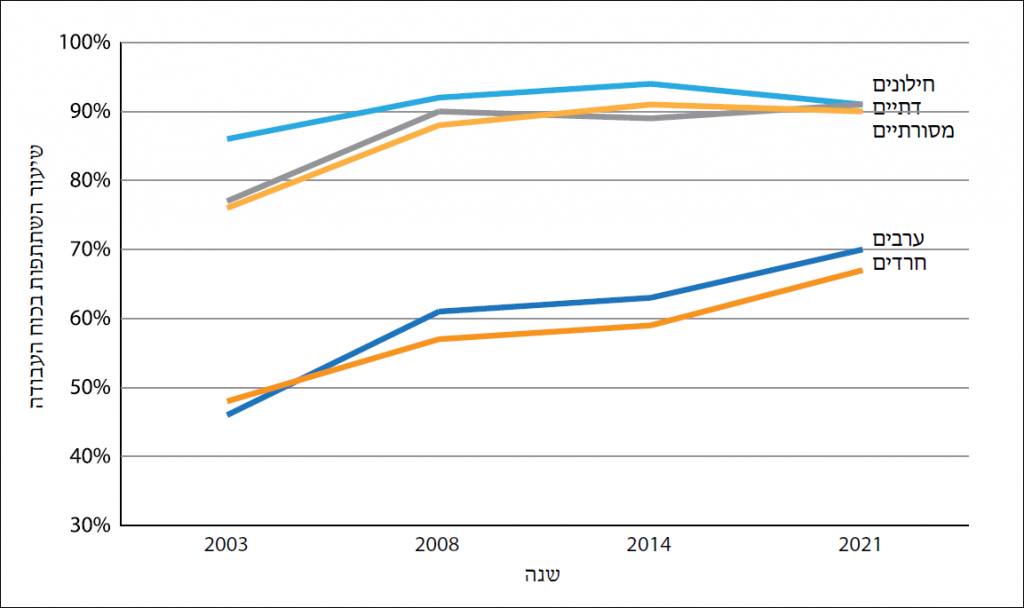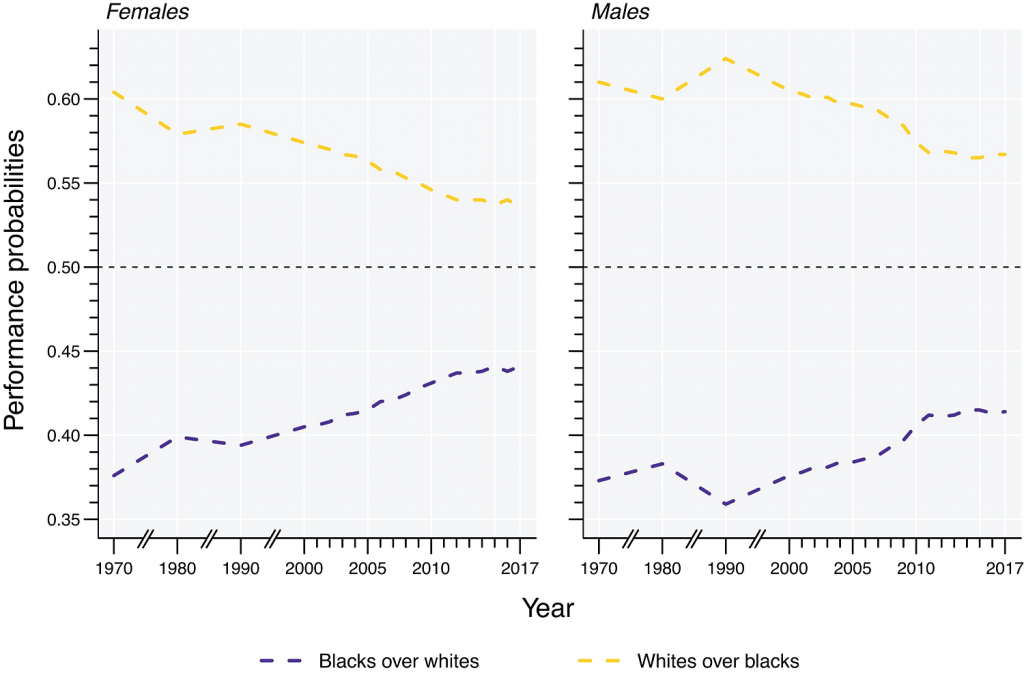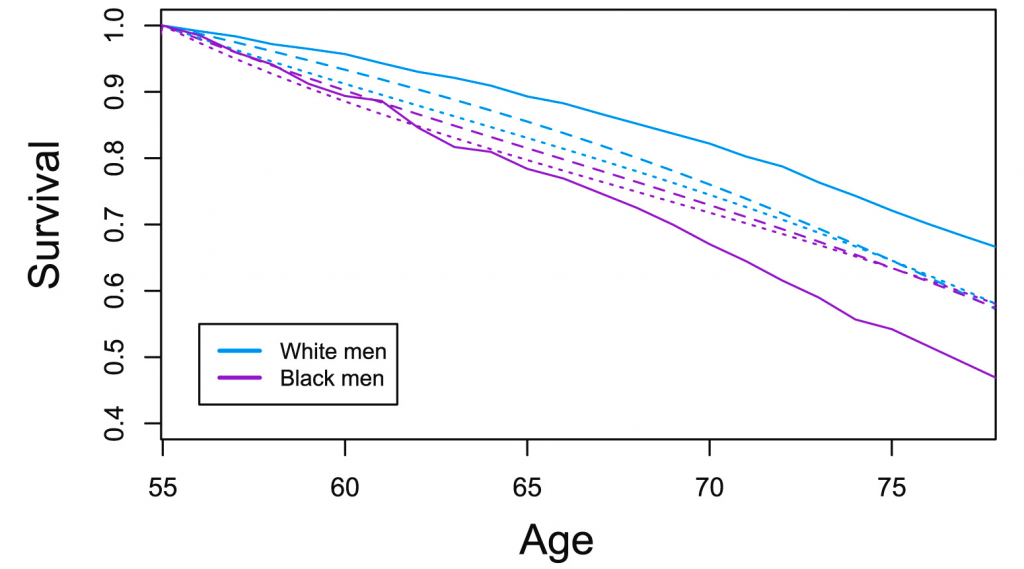At the Population Research Center and Center on Aging and Population Sciences Friday Seminar Series (March 22).
Upcoming talk at the University of Wisconsin-Madison

Upcoming talk at Harvard University
Upcoming talk at Oxford University
Sociology Seminar Series at Nuffield College (January 17)
Social Inequalities in Bereavement across the Life Course: A Study of Four-Generation Kinship Networks in Sweden
https://www.nuffield.ox.ac.uk/news-events/events-and-seminars/sociology-seminar-ht24-week-1/
Commentary on Measuring Jewish Identity in Population Surveys published in Contemporary Jewry
Measuring Jewish identity in population surveys is challenging. In most countries Jews are a small minority group, which requires wide canvassing efforts to collect sufficiently large representative samples. Moreover, Jewish identity reflects a mixture of religion, ancestry, and culture, which make it difficult for analysts to decide who to include or exclude from their estimates. For example, people may identify as Jewish even if they do not follow religious practices, and consider themselves agnostic or atheist.
How should demographers conceptualize Jewish identity in population surveys and how should they measure it? In a commentary in Contemporary Jewry, I propose several lessons for measuring Jewish identity based on current practices for racial and ethnic categorization in population censuses.
A Demographic Perspective on Israel’s Regime Crisis: New paper in Israeli Sociology (with Yossi Harpaz)
Abstract: Against the backdrop of the attempted judicial overhaul, tensions between different sectors in Israeli society are intensifying. In this paper, we revisit the seminal work of Baruch Kimmerling, who announced the end of secular Zionist hegemony and the emergence of succession struggles. We analyze recent shifts in demographic, economic, and political power relations among the five main sectors of Israeli society: secular, traditional and national-religious Jews, ultra-Orthodox Jews, and Arabs. Despite its political weakening, the secular sector maintains its position of leadership in terms of economic power and military recruitment rates. Together, these factors grant it structural power and provide a means of resisting the judicial overhaul. Conversely, the political power of the national-religious sector is increasing, while the political representation of the Arab and ultra-Orthodox sectors remains substantially unchanged. This finding casts doubt on the approach that we label demographic determinism, which assumes that population growth translates directly into political power. Lastly, we propose that the struggle between the two forms of Israeli nationalism, secular-liberal and religious-particularistic, will be decided by the traditional sector, whose complex religious, ethnic, and class position places it in the middle between the two camps.
Figure: Labor force participation rates in Israel by ethnicity and religiosity, ages 30-49.

Read the full paper (in Hebrew) here.
Poverty in early childhood and future educational achievements (with Dana Shay and Yossi Shavit)
Read our paper in Early Child Development and Care.
Paper published in the Journal of the Royal Statistical Society, Series A (with Iñaki Permanyer & Francisco Villavicencio)
A new decomposition method of inequality in length of life to reconcile group- and individual-based approaches to health inequality. Rather than focus on group differences in life expectancy, it allows us to answer, for example, what is the probability that a white American outlives a black American (or vice versa) and how has the survival advantage/disadvantage changed over time? Read more here.
Figure: Over- and under-performance probabilities for black and whites Americans by gender, 1970-2017.

Postdoctoral vacancy at the BMI Demography Lab
Looking for a postdoctoral fellow to join an ISF-funded research project on mortality inequalities in the United States and in Israel. The position is offered for two years, to begin no later than October 2023. See the call for applications for additional information.
Paper published in SSM-Population Health (with Shayna Bernstein)
Do Americans who expect to live longer actually live longer? The answer varies by race and gender. For example, white men on average underestimate their longevity whereas black men overestimate it. Why? Read the full paper here.
Figure: Subjective vs. objective survival among black and white American men, 1937-1941 birth cohort. Actual survival of 1992 survey respondents through 2018 (solid line); subjective survival based on Weibull (dashed line) and Gompertz (dotted line) models.

Awarded Center Grant from the Ministry of Innovation, Science & Technology
The five-year grant (with Itai Sened, Vered Blass, Asher Tishler, and Hadas Mamane Steindel) will kickstart the Applied Systems Analysis Excellence Center at Tel Aviv University. As head of the center’s demography branch, I encourage doctoral and postdoctoral researchers who are interested in joining to contact me directly.
Demography session at the IIASA-Israel Symposium
Announcing the 54th annual meeting of the Israeli Sociological Society, to be held at Tel Aviv University
Awarded ISF Personal Research Grant to study “the social dynamics of lifespan inequality”
The study will examine inequalities in length of life, over time, by class, gender, and race/ethnicity in Israel and the United States. It will draw on diverse data sources, ranging from census and population registry data (Israel) to vital statistics data (US).
“Class-Based Inequalities in Health and Mortality in Israel:” review paper published in Israeli Sociology (with Atalia Regev)
Abstract: Israel, like other high-income countries, exhibits substantial and rising class disparities in health and mortality. Individuals with high levels of education and income benefit on average from better physical and cognitive health, as well as lower mortality rates. Yet in spite of the importance of socioeconomic disparities for health inequality, this area of research received little attention in Israeli sociological research. As a result, key sociological insights are absent from public and academic discussions on health inequalities and how to reduce them. In this article we first review the causal mechanisms for explaining class-based disparities in health and mortality, emphasizing three theoretical frameworks: health lifestyle theory, the life course approach to health disparities, and the chronic stress paradigm. Second, we provide an empirical review of class-based inequalities in health and mortality in Israel. Lastly, we propose new directions for research on health inequalities in Israel, pointing to underutilized data sources and highlighting patterns and trends unique to Israeli society.
Full paper (in Hebrew) available here
Profile on COVID-19 demographic database published in International Journal of Epidemiology
Glad to have taken part in this important project, involving more than 80 researchers worldwide and led by Tim Riffe and Enrique Acosta from the Max Planck Institute for Demographic Research. Special thanks to Erez Shomron, a former student and member of my Demography Lab, who was instrumental in integrating the Israeli COVID-19 data in COVerAGE-DB.
A collaboration of demographers worldwide led by @timriffe1 and @Acosta_Kike_ made the COVerAGE-DB database for #COVID19 cases and deaths possible. The paper is published in @IntJEpidemiol https://t.co/PIobmPMSUK pic.twitter.com/Y1kB6pM12V
— MPIDR (@MPIDRnews) May 18, 2021
Upcoming Webinar: New Perspectives on Lifespan Inequality
The Herczeg Institute on Aging at Tel Aviv University, in collaboration with the Interdisciplinary Centre on Population Dynamics (University of Southern Denmark) and the Leverhulme Center for Demographic Science (Oxford University), is pleased to announce its upcoming webinar on New Perspectives on Lifespan Inequality.
The webinar will be held on January 21st 2021 at 4 PM Israel time | 3 PM CET | 9 AM EST. Participation is free.
To register please visit https://tinyurl.com/lifespan2021 or contact tomaival@tauex.tau.ac.il at the Herczeg Institute on Aging.
*** Update (January 24, 2021): Video now available
Aging and COVID-19 mortality: What do we currently know?
COVID-19 is often portrayed as a “disease of the elderly,” but is this portrayal supported by the evidence? How does the risk of dying from COVID-19 vary by age? How does it compare with other causes of death? And how does the age pattern of COVID-19 mortality differ across countries? In this study I attempt to answer these questions and others about the relationship between COVID-19 mortality and age.
*** Update (February 17, 2021): Now published in Demographic Research

Age-specific mortality rates of COVID-19 (2020) and Pneumonia & Influenza (1999–2018), United States. Pneumonia & Influenza mortality rates based on Centers for Disease Control and Prevention vital statistics, adjusted to the same calendar period as COVID-19 provisional mortality data.
Persistent regional inequalities in mortality in Finland and Sweden: New article in Population, Space and Place
“Regional trajectories in life expectancy and lifespan variation: Persistent inequality in two Nordic welfare states” published in PSP (with SUDA researchers Ben Wilson, Sven Drefahl, Paul Henery, and Caroline Uggla).
Key finding: In both Finland and Sweden, life expectancy increased and lifespan inequality decreased in all regions between 1990 and 2014. However, in spite of the improvement in national trends, regional inequalities in life expectancy and lifespan inequality have remained stable, in each country, during this period.

Regional life expectancy at birth in Sweden and Finland (Men).
Postdoctoral vacancy at the BMI Demography Lab
Recruiting a postdoctoral fellow to join my Demography Lab, currently focusing on social inequalities in health and mortality. The position is for 1 to 2 years and will start on October 2020. For additional information see the call for applications.
New article in Middle Eastern Studies
My first foray into historical sociology published in Middle Eastern Studies (with Ronen Shamir). Our study traces the politics of census-making in British-ruled Palestine surrounding the question of Arab landlessness. Based on archival work, we demonstrate how Jewish statistical expertise and British adherence to their colonial experience in India allowed them to shape the 1931 Census of Palestine, and the type of data it would collect, without appearing political.

Abba Ahimeir, member of the Zionist Revisionist Movement, standing next to wall graffiti urging Jews not to participate in the census. November 1931, unknown photographer, Jabotinsky Institute in Israel.
Workshop on Inequalities in Health, Longevity and Aging
I am pleased to announce the 2nd Tel Aviv Workshop on Inequalities in Health, Longevity, and Aging. The workshop is organized in collaboration with the Interdisciplinary Centre on Population Dynamics at the University of Southern Denmark and the Herczeg Institute on Aging. The international seminar and workshop will be held at Tel Aviv University on 5-7 May, 2020. For additional information see the call for papers.
*** Update (March 9, 2020): The workshop has been cancelled due to COVID-19.
Visit at the European University Institute in Florence
I will be spending the fall semester at the EUI’s Department of Political and Social Sciences and Comparative Life Course and Inequality Research Centre (CLIC) as Visiting Fellow. Special thanks to Fabrizio Bernardi and Juho Härkönen for inviting me and organizing the Health Inequality Workshop.
Come & join us for today's Health Inequality Workshop:https://t.co/TPGwk81Py5
Organised by the CLIC and FloPS, a collaboration of population researchers between the University of Florence and the EUI.
(!) Today from 13:30 to 18:00 at Emeroteca, Badia Fiesolana.
— CLIC – IWG (@clic_iwg) December 2, 2019
“Association between Educational Attainment and Causes of Death Among White and Black US Adults, 2010–2017” published in JAMA (with Mark Hayward)
Estimated life expectancy at age 25 in 2010-2017 declined overall among people without a 4-y college degree and increased among those w college-education. Much of thedifference was attributable to drug use https://t.co/c6rxX5QJ8J @jamaforum
— JAMA (@JAMA_current) August 29, 2019
“The social shaping of uncertainty in length of life” presented at the Healthy Aging Symposium (Tel Aviv University)
Forecasting Israeli mortality and life expectancy in 2065 (research report for Bituah Leumi)
Long-term mortality forecasts are critical for government planning and welfare provision, because life expectancy has direct implications for health expenditure and old-age state pensions, among other factors. Yet, forecasting Israeli life expectancy has proven especially challenging for several reasons.
First, while Israel’s life expectancy at birth is one of the highest in the world, its historical mortality record is rather short compared to other countries. When data are scarce demographers often turn to similar countries, learn from their past experience, and apply a model to the country with limited data (that is, in very broad terms, the approach adopted by the UN Population Division). But Israel has only a handful of countries to learn from–such as Japan, Italy, and Switzerland–and even in those cases we can, at best, hope to gain insight a mere decade or two into the future.
Second, Israel’s population is composed of several social groups with unique characteristics and mortality profiles. Population heterogeneity makes forecasting difficult, because forecasting for the population as a whole overlooks important components of change (and is therefore less accurate). On the other hand, forecasting for each social group separately results in divergent forecasts in the long run, which do not conform to the national trend.
For these reasons, among others, previous mortality forecasts for Israel have often missed the target, either underestimating or overestimating life expectancy at birth. In a research report prepared for Bituah Leumi (National Insurance Institute of Israel), I review past mortality forecasts and why they have been unsuccessful, compare alternative models for forecasting mortality, and produce my own forecast for Israeli life expectancy in 2065.
“The case for monitoring life-span inequality” published in Science (with Alyson van Raalte & Pekka Martikainen)
The case for monitoring life-span inequality is over-whelming: https://t.co/fRHw3KS1qK (DOI: 10.1126/science.aau5811) pic.twitter.com/mUSVRwS8ob
— PRU HelsinkiUni (@PRUhelsinkiuni) January 18, 2019


